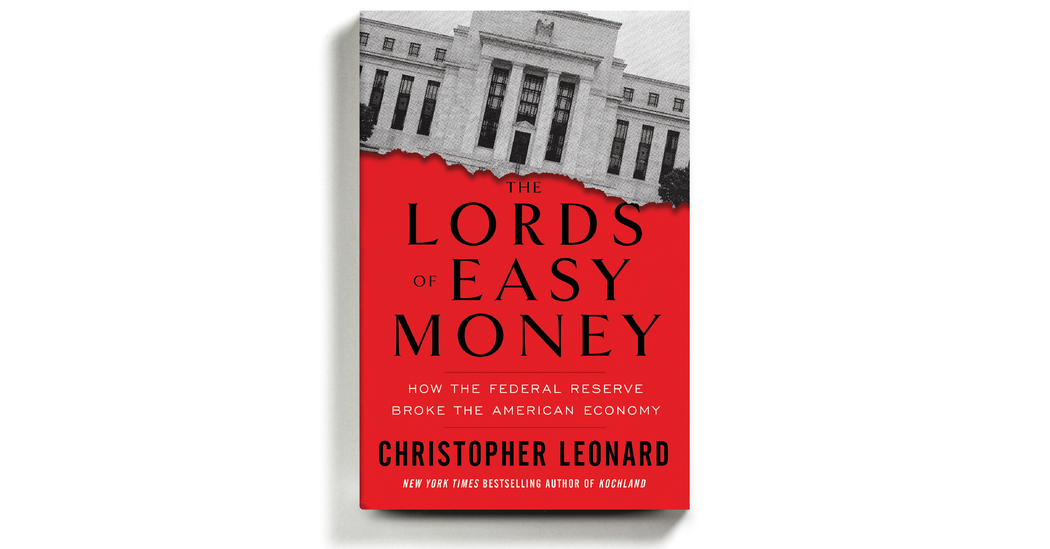
There’s something undeniably gratifying about an elegantly crafted morality tale — and the business reporter Christopher Leonard has written a good one, even if you suspect that the full shape of it isn’t quite as smooth as he makes it out to be. “The Lords of Easy Money” is a fascinating and propulsive story about the Federal Reserve — yes, you read that right. Leonard, in the tradition of Michael Lewis, has taken an arcane subject, rife with the risk of incomprehensibility (or boredom), and built a riveting narrative in which the stakes couldn’t be any clearer.
The stakes, that is, as Leonard and his protagonist define them, which is the fulcrum on which this entire book turns. “The Lords of Easy Money” filters an argument about the Fed through the experience and worldview of a retired central banker named Thomas Hoenig, who joined the Kansas City Fed in 1973, first as a bank regulator, then ascended the ranks to earn a seat in 1991 at the Federal Open Market Committee, where real decisions about monetary policy get made.
For years, Hoenig — described by Leonard as a “rule-follower” — fit right in. With few exceptions, he voted yes to what Alan Greenspan, the chairman at the time, wanted to do, and then voted yes to what the next chairman, Ben Bernanke, wanted to do. Then came 2010, when Hoenig cast a string of lone dissenting votes on a committee of 12 where unanimity was prized.
What Hoenig adamantly objected to was the Fed’s decision to keep interest rates at zero and begin a new round of buying long-term government debt, a policy known as “quantitative easing,” which effectively injected trillions of new dollars into the banking system — the “easy money” of the book’s title. An inflation hawk (so troubled by the prospect of rising prices that he was keen to limit the Fed’s reach), Hoenig had been fine with such measures during the 2008 financial crisis, when markets were cratering; but he didn’t think that an unemployment rate of 9.6 percent amounted to the kind of emergency that called for turning extraordinary methods for expanding the money supply into a matter of course.
A large part of “The Lords of Easy Money” is given over to trying to rehabilitate Hoenig’s reputation, which took a hit when, year after year, the inflation he warned about failed to happen. But inflation did happen, Leonard repeatedly emphasizes, just not in the form that people thought it would take.
What escalated weren’t consumer prices but asset prices: In the last decade, the stock market boomed while the real economy sputtered along. Hedge funds, banks and private equity firms were all incentivized to create newer, riskier and ever more exotic forms of debt. All that new money was helping to fund another speculative bubble while simultaneously leaving little room for the Fed to maneuver in the event of another crash. Leonard says that this asset speculation further enriched the wealthy few while work became ever more precarious for the many.
The last third of the book introduces us to one of the many: John Feltner, who in 2013 landed a unionized job at Rexnord, a manufacturer of heavy-industry equipment, just a few years before the company decided to move his Indianapolis plant to Mexico. Leonard has chosen Rexnord as an example advisedly. First, starting in the 1980s, a string of private equity firms saddled Rexnord with so much debt that the company’s reason for being became the servicing of that debt. Second, one of the private equity firms that acquired Rexnord in the early 2000s was the Carlyle Group, and one of the partners of the Carlyle Group at the time was Jerome Powell, currently the chair of the Federal Reserve. Powell was appointed as the chair in 2018 by then-President Donald Trump — the same Donald Trump whose populist rhetoric had gotten the vote of a frustrated Feltner two years before.
All of this usefully highlights how extreme financialization has transformed (or deformed) the economy and our politics, even if Powell’s connection to Rexnord ended long before Feltner worked there and his job was moved to Mexico. Powell, who last week signaled a willingness to raise interest rates if inflation persists, is depicted as someone so protean that it’s almost as if he’s the personification of the financial system writ large — an improvisational, politically astute operator to Hoenig’s principled but doomed Cassandra. Powell’s good standing among the Washington establishment comes across as suspect, though Leonard has no patience for anti-establishment conspiracy theories either, and he laments that criticisms of the Fed’s easy-money policies in the last decade have mainly been the purview of “right-wing cranks.” He takes a great deal of care making Hoenig’s hawkishness sound like good old common sense — as if it’s simply the inevitable conclusion drawn by a stalwart steward of “prudence and integrity.”
Which it very well may be, though Hoenig’s hard-line position glides through this book mostly uncontested, with only a scant sense of why it didn’t win over the other economists at the Fed. You wouldn’t know that there have been any serious developments in economic ideas since Hoenig was deeply influenced by the inflationary spiral of the 1970s. There is no mention at all of modern monetary theory, advocated most prominently by the economist Stephanie Kelton, which takes to heart a line from John Maynard Keynes: “Anything we can actually do, we can afford.” Even if Hoenig thinks it’s utter garbage, it would have been good to see exactly how, when pressed, he makes his case.
Nor does Leonard address what could have happened if Hoenig had gotten his way back in 2010. What the economic historian Adam Tooze calls the “deflationary misery” of the 1930s loomed understandably large in the Fed’s institutional memory, a terrible reminder of what could happen when the institution failed to counteract a collapsing banking system by buoying the money supply. Not to mention that in 2010 the Fed’s actions indicated that it had become a guarantor not just for the American economy but for the global financial system. Tooze’s recent books, “Crashed” and “Shutdown,” suggest that the relationships between the Fed, the U.S. economy and the global system have all been torqued to the point where an urge to stand athwart it all, yelling “stop,” is futile.
Leonard (or Hoenig) is right to recognize how precarious, and how dangerous, the current situation is. Leonard (or Hoenig) is right to call for some “long-term thinking,” too. Still, “The Lords of Easy Money” presents the complexity of the current system as if it were merely disguising some unshakable fundamentals; there’s a satisfying clarity to reading a book that puts the jumble of political and economic turmoil into such stark narrative terms, but there’s more to the story than that.




